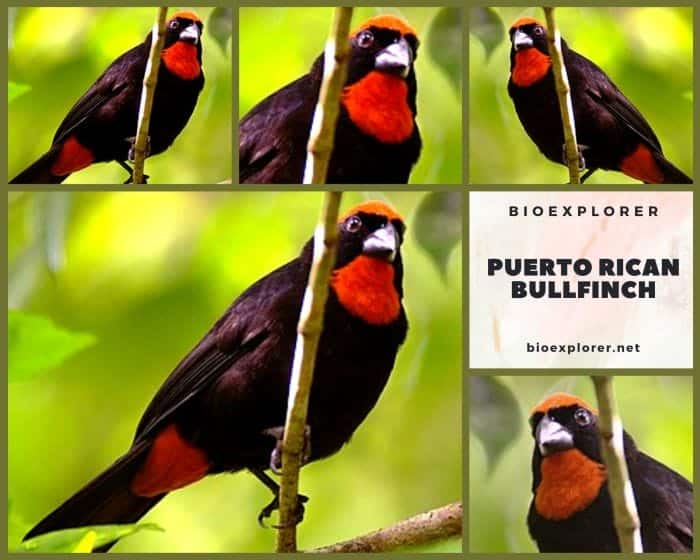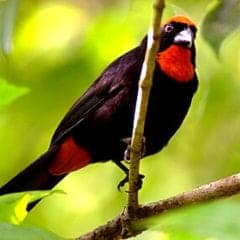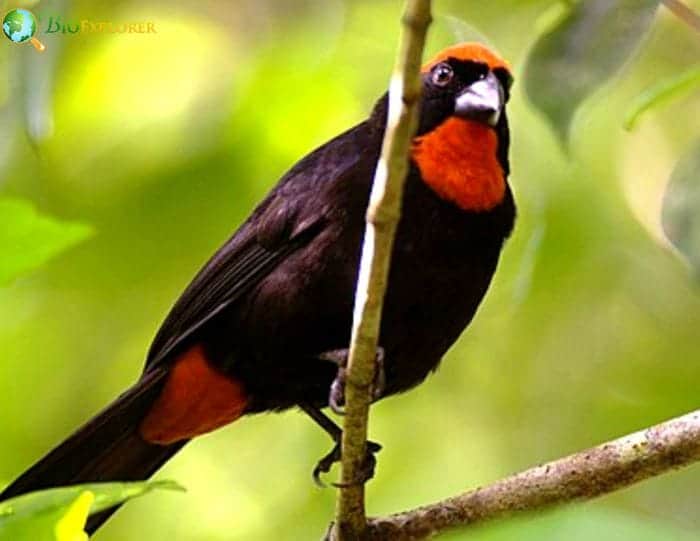
| Animalia | Passeriformes | Thraupidae | Melopyrrha | Melopyrrha portoricensis |
The Puerto Rican Bullfinch (Melopyrrha portoricensis) is a stocky 17-19 cm frugivorous songbird adorned in black plumage offset by bright orange eye rings, throat patches, and undertail covers.


- Common Name(s): Puerto Rican Bullfinch
- Family: Fringillidae
- Body Dimensions: 17–19 cm
- Male Plumage Color(s): Black With Orange Eye Rings, Throat Patch and Undertail Covers
- Female Plumage Color(s): Black With Orange Eye Rings, Throat Patch and Undertail Covers
- Habitat: Rainforests and Brush
- Diet: Fruit, Seeds, Insects, Spiders
- Native Countries: Puerto Rico
- Continent(s): North America
- Taxonomy Classification Year: 1800
- Taxonomist(s): François Marie Daudin
Puerto Rican Bullfinch Fun Facts

- Endemic across forested areas of Puerto Rico except the eastern tip, this Bullfinch relative feeds on fruits, seeds, spiders, and insects foraged through dense canopy and tangled undergrowth.
- Often joining mixed-species flocks socially foraging and roosting, pairs construct globular nests woven from grasses and bark.
- Lined internally with soft fibers, a side entrance accesses a cozy chamber typically nurturing 3 dull green eggs marked in dark speckles.
- While the Puerto Rican Bullfinch likely breeds between March and June, opportunistic nesting can occur year-round if ample fruit resources sustain breeding conditions[1].
- Still, Habitat Loss and nest predation by animals like the Pearly-eyed Thrasher curtail reproductive success.
- Competition from Africanized honeybees over tree cavity nest sites poses an emerging threat. So, while not yet near threatened, population declines tied to encroaching agriculture and development jeopardize the Puerto Rican Bullfinch’s long-term outlook.
- Protecting precious tracts of mature rainforest – especially fruiting trees, which are key to wildlife nutrition needs – is central to this species’ preservation.
- Sustaining adequate habitat buffers from coffee plantations and human infrastructure also allows this adaptable endemic to shift the range impacted by climate change.
Safeguarding essential forest resources to shelter the boldly decorated Puerto Rican Bullfinch remains the keystone for conservation across Puerto Rico’s ecological mosaic.
Suggested Reading: Puerto Rico Birds | Cassin’s Finch
Cite This Page
APA7MLA8Chicago
BioExplorer.net. (2025, April 14). Puerto Rican Bullfinch. Bio Explorer. https://www.bioexplorer.net/animals/birds/puerto-rican-bullfinch/.
BioExplorer.net. "Puerto Rican Bullfinch" Bio Explorer, 14 April 2025, https://www.bioexplorer.net/animals/birds/puerto-rican-bullfinch/.
BioExplorer.net. "Puerto Rican Bullfinch" Bio Explorer, April 14 2025. https://www.bioexplorer.net/animals/birds/puerto-rican-bullfinch/.










